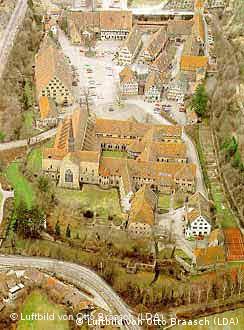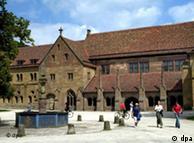
Maulbronn Monastery as seen from the heavens
"Location, location, location" would be a fitting motto for the Maulbronn Monastery Concerts, where the spirit of "ora et labora" (prayer and work) has a palpable effect on audiences and musicians.
Hermann Hesse, the most popular German author of modern times, concerned himself in many of his books with the power of art. It’s impossible not to think of Hesse, who as a student spent some time at Maulbronn Monastery, while listening to music played under the stone arches of this austere former dining hall for lay monks.
Performed by the Offenburg String Trio and Stefan Schilli (oboe) at Maulbronn Monastery on July 15, 2007 and recorded by DeutschlandRadio Kultur, Berlin (DLR):
- Jean Francaix (1912-1997): Quartet for English horn and string trio (1971)
- Wolfgang Amadeus Mozart (1945-1791): Quartet in F Major for oboe and string trio, K. 370 (1781)
Performed by the Offenburg String Trio on 07985 BM-CD 31.9185:
- Jean Cras (1879-1932): Trio for Violin, Viola and Cello (excerpt)
Rebroadcasting Rights: one broadcast no later than September 29, 2008
Maulbronn Abbey (German: Kloster Maulbronn) is the best preserved medieval Cistercian monastery complex in Europe. It is situated on the outskirts of Maulbronn, Baden-Württemberg, Germany and is separated from the town by fortifications.
The monastery was founded in 1147 under the auspices of the first Cistercian pope, Eugenius III. The main church, built in a style transitional from Romanesque to Gothic, was consecrated in 1178 by Arnold, Bishop of Speyer. A number of other buildings — infirmary, refectory, cellar, auditorium, porch, south cloister, hall, another refectory, forge, inn, cooperage, mill, and chapel — followed in the course of the 13th century. The west, east and north cloisters date back to the 14th century, as do most fortifications and the fountain house.
After the Reformation broke out, the Duke of Württemberg seized the monastery in 1504 and built his hunting lodge and stables there. Half a century later, the former abbey was given over to a Protestant seminary, currently known as the Evangelical Seminaries of Maulbronn and Blaubeuren, which has occupied it ever since. The Protestant clerics adapted the monastic buildings for their own needs, e.g., they rebuilt the refectory.大餐廳
The monastery, which features prominently in Hermann Hesse's novel Beneath the Wheel, was inscribed on the World Heritage List in 1993. The justification for the inscription was as follows: "The Maulbronn complex is the most complete survival of a Cistercian monastic establishment in Europe, in particular because of the survival of its extensive water-management system of reservoirs and channels".
毛爾布龍修道院原為西妥教團修道院(Zisterzienserabtei)前身,位於德國巴登-符騰堡邦,接近普福爾茨海姆。毛爾布龍的外圍,雷山西北方,為黑森林與歐登森林的交界處。修道院是阿爾卑斯山北面所存留保存最好的中世紀修道院群,皆是從羅馬式到後歌德式建築的形式潮流與發展過程代表。
整個修道院群由封閉的城牆包圍,其中包括毛爾布龍市政廳,警局,餐廳,九到十年級的福音派大學預校(文理中學)與其他公家機關等。從1993年十二月起為聯合國教科文組織列為世界文化遺產。
Insight | 30.08.2008 | 04:30
Unesco World Heritage Sites: The monastery in Maulbronn
Founded in the middle of the 12th century, the monastery and medieval village of Maulbronn, near Stuttgart in south-west Germany, became a UNESCO World Heritage Site in 1993.
Maulbronn is a Unesco World Heritage Site of outstanding architecture, capturing a time of transition from Romanesque to early Gothic styles. After nearly 400 years as a Roman Catholic monastery, Maulbronn became a Protestant seminary and boarding school, hosting a long list of famous students. It’s therefore a site of important religious, architectural and cultural significance.
Report: Geoff Rodoreda

沒有留言:
張貼留言